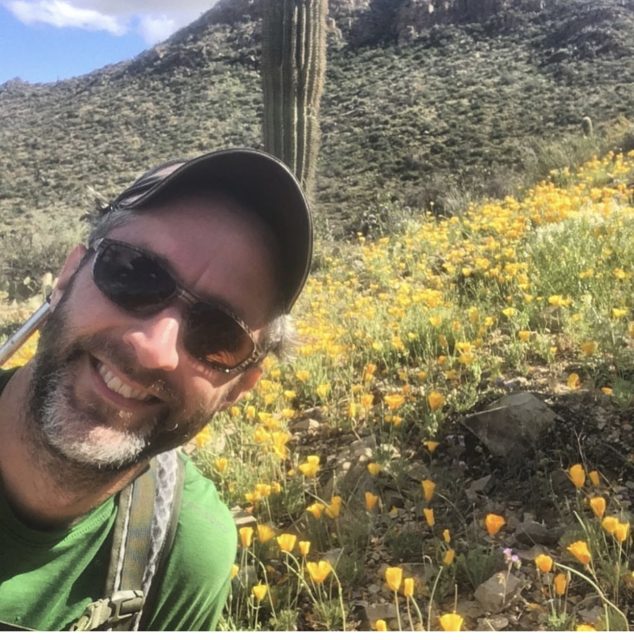
Michael Bogan is an assistant professor at the University of Arizona using his camera lens to change the way we think about aquatic and riparian research. Michael Bogan has dedicated his career to understanding how aquatic species cope with floods and drought, which makes him the perfect tour guide for our Dragonfly Day on the Santa Cruz River event on Nov. 9th.Before coming to U of A, Michael acted as a David H. Smith Conservation Research Fellow at the University of California Berkley, and a graduate student researcher at Oregon State University.
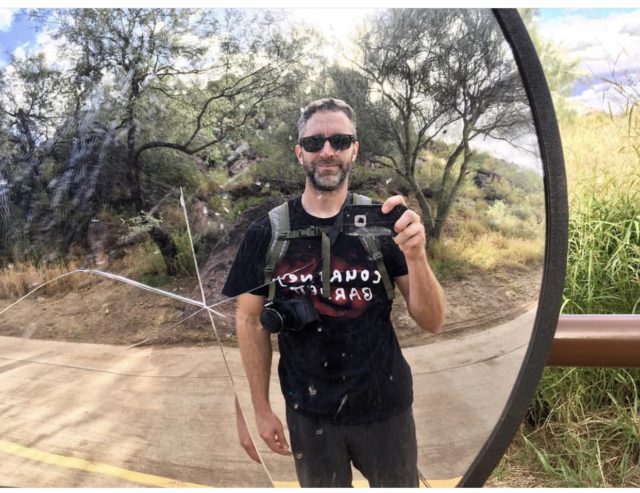
We wanted to learn more about Michael, the use of photography in his work, and yes, his small obsession with dragonflies:
What drew you to dragonflies in particular?
Dragonflies play really important roles in aquatic and riparian ecosystems—and they’re beautiful! I’ve been fascinated with dragonflies since I started as an aquatic ecologist nearly 20 years ago. Even in those early days, when I mostly studied fish and frogs, dragonfly larvae always grabbed my attention. Dragonfly larvae essentially have an extendable face, like the monsters in the movie Alien. The larvae can extend their specialized mouthparts far away from their faces, grabbing their unsuspecting prey with sharp hooks and spines, and then snapping their prey back to the underside of their heads, where they chew on the prey with their mandibles and ingest the chewed-up pieces- it’s vicious!
What are some facts about dragonflies that people may not know?
People also may be surprised by how far some dragonflies can fly. One incredible species, called the Wandering Glider, makes migratory flights across oceans! The larvae live in ponds in India, and when the adults emerge from those ponds, they fly across the Indian Ocean and land in Africa. Once there, they mate and lay eggs, and when those larvae mature, the adults emerge and fly back to India to complete the migratory cycle.
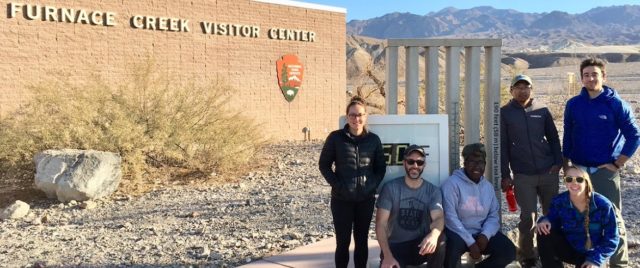
What do you study at your lab at the University of Arizona? Is there a project you are currently working on that you are excited about?
My lab group studies the species that live in and depend upon desert streams and riparian areas. The goal of most of our projects is to understand how disturbances, like stream drying or wildfire, affect aquatic and riparian biodiversity, and how animals have (or have not) developed adaptations to survive things like drought. We are working on many projects, but there are a couple that I’m most excited about:
A collaborative study involving researchers from all corners of the U.S. to assess and understand how the drying of streams affects biodiversity in various climate zones.
The Santa Cruz River Heritage Project– this project brought back the river flow and lots of research opportunities along with it! For example, we are monitoring how quickly aquatic insects and aquatic vertebrates (such as fish and frogs) are returning this new reach of the river downtown. It’s really fun to study a river that runs right through the heart of our city!
How do the projects in your lab connect to dragonflies?
Some dragonflies can be extremely sensitive to stream drying; we track the distribution of dragonflies in the area to help identify streams that have year-round water supplies or that dry seasonally. We also study the role that dragonflies play in the wellbeing of aquatic ecosystems and the people that live near them. For example, mature dragonflies give humans a helping hand by eating mosquitoes and other flying pests in our city. A decrease in dragonfly populations could cause a spike of pest populations or create an unbalance between aquatic and riparian ecosystems—and negatively affect species in riparian habitats, such as birds and bats.
…Any scientist worth listening to must be something of an artist, to fully convey their love of what they study. Merging art and science just seems natural to me.
–Michael Bogan, assistant professor and researcher at the University of Arizona.
Are dragonflies impacted by climate change or environmental pollution? How?
As with any group of animals, the answers to these questions are complex. Our warming climate is allowing some species of dragonflies to thrive and move further north from the tropics—we’ve seen tropical species become established in southern Arizona in the last few years! However, other species of dragonflies require cold water, and these are negatively affected by warming. Similarly, some dragonflies are tolerant of many types of environmental pollution, while others only live in the most pristine aquatic habitats. That’s why we must get to know our local dragonfly species! We can use this information to tell us a lot about our local climate and environment.
What inspired you to pursue photography?
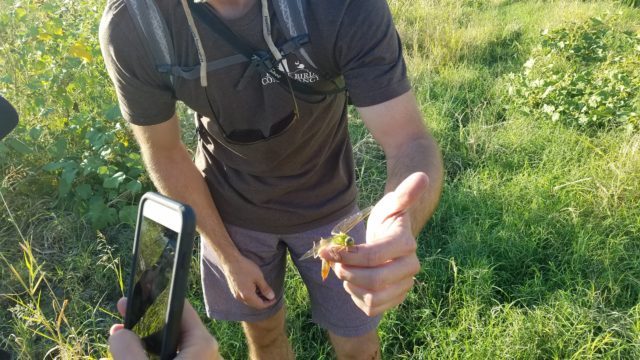
I have been interested in photography for a long time! As a teenager, I was very interested in black-and-white photography—I even learned to develop film and make my own prints. I spent a lot of time in dark rooms. Once digital and macrophotography became cheaper and easier, I adopted those approaches into my research—it’s helpful to be able to have good photos of insects to show people and get them more interested in your studies. In 2017, Doug Danforth, a regional dragonfly expert, introduced me to an affordable but powerful telephoto camera (Canon Powershot SX60). That camera and an excellent field guide called The Dragonflies and Damselflies of Arizona and Sonora are responsible for my current obsession with photographing and studying dragonflies.
What do you hope people get from your photos?
I hope people experience the same joy that I do when I see these colorful jewels flying around our local streams. I also hope people recognize and appreciate the unique species and natural beauty of their city—in the Santa Cruz River or in ponds in our local parks. Many of these species are dragonflies that you can’t see anywhere else in the country—so we’re fortunate to live here!
You were featured in the 6×6 exhibit at the UA Museum of Art. I thought it was a great example of how the arts & sciences can find a happy medium together without being boring or losing the educational benefits.

Can you describe your philosophy when combining art and research? Is there a “balancing act” when communicating the best of both worlds?
I think my perspective is different from some scientists because I came to ecology and science relatively late—after I’d had other jobs and careers and a strong interest in the arts. It’s interesting how art and science are perceived as being polar opposites, but really art and science are not separate fields at all—they both are about observing the world, the worlds within us, and communicating those observations to other people.
In the 6×6 exhibit, I was lucky to be paired with a wonderful artist, Kathleen Velo, who has a scientist’s mind when it comes to observing the natural world, but the training of an artist to create dynamic visual works. To paraphrase a famous old Tucsonan desert rat, great artists often start with keen observations of the natural world, and any scientist worth listening to must be something of an artist, to fully convey their love of what they study. Merging art and science just seems natural to me.
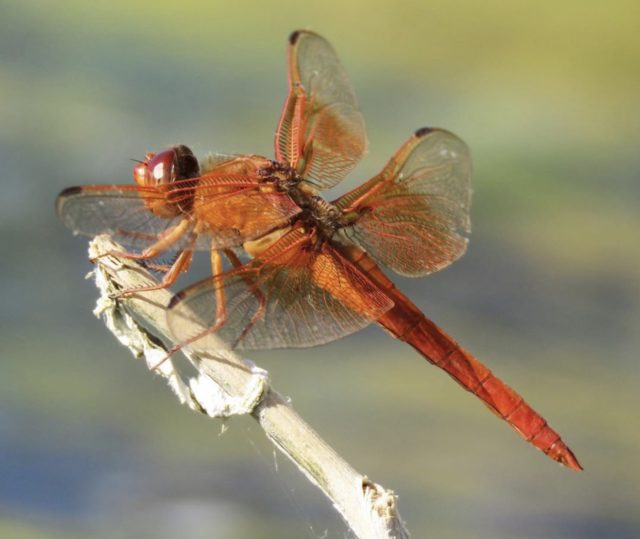
I hope people experience the same joy that I do when I see these colorful jewels flying around our local streams. I also hope people recognize and appreciate the unique species and natural beauty of their city…
What is the upcoming event, Dragonfly Day on the Santa Cruz River?
This is a fun event we’re planning with Sonoran Institute and Pima County to draw attention to the colorful biodiversity we have in our own backyard here in Tucson! We hope to bring our community closer to the river by sharing our love for the SCR’s resident dragonflies—both by getting our feet wet looking for dragonfly larvae underwater and by introducing folks to dragonfly watching and photography.
What do you hope attendees will get out of the Dragonfly Day experience?
I hope folks will see the amazing, colorful, and beautiful biodiversity that we have locally even in ecosystems that were so historically degraded, like the Santa Cruz River. With a little careful management and community investment, we can have both the urban amenities we like, while also creating a habitat for dragonflies and countless other species!
Join us and Michael Bogan on November 11th to learn about the life of dragonflies through family-friendly, hands-on activities. To learn more about the event and all of the activities please visit our Facebook Dragonfly Day event page.
Dragonfly Day on the Santa Cruz River is sponsored by: Pima County Regional Flood Control District. Event partners include Pima County Natural Resources Parks and Recreation, Sonoran Institute, Town of Marana Parks and Recreation, and University of Arizona’s School of Natural Resources and the Environment.
Blog Post By: Grace Wofford, Marketing Communications Intern
